Fri 30 Apr 2021
A Movie Review by David Friend: DEADLIER THAN THE MALE (1967).
Posted by Steve under Reviews , Suspense & espionage films[6] Comments
DEADLIER THAN THE MALE. Rank, UK, 1966. Universal, US, 1967. Richard Johnson (Hugh Drummond), Elke Sommer, Sylva Koscina, Nigel Green, Suzanna Leigh, Steve Carlson. Screenwriters: Jimmy Sangster, David Osborn) & Liz Charles-Williams, based on a original story by Jimmy Sangster and the character Bulldog Drummond created by Herman C. McNeile (as Sapper) & Gerard Fairlie. Directed by Ralph Thomas.

By the late 1960s, almost everyone was cashing in on the wildly successful Bond films and seeing if they could make their own without breaking the international copyright laws. This splurge of spy movies gave us the two Derek Flint films with James Coburn, the four Matt Helm films, questionably starring Dean Martin, and – closer to home – the so-called ‘Euro-spy’ films. These were badly-dubbed Italian and French films which featured a Bond-like character.
Here in Britain, we also had the Harry Palmer films, The Quiller Memorandum, Hot Enough for June and Modesty Blaise, along with comedies like Carry On Spying and that one with Morcambe & Wise.
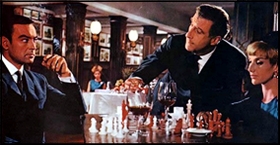
So it was only expected that some bright spark would dust off the old Bulldog Drummond adventure novels by 1920s writer ‘Sapper’ which were partly responsible for Bond in the first place. The original character is considered to be a racist bigot now, but he was more or less Bertie Wooster with a penchant for brutal justice and initially went up against criminal mastermind Carl Peterson.
This film, however, strips Drummond of his nick-name, military rank, character, backstory, supporting cast and storylines and makes him a smooth, wryly-amusing insurance investigator with a Rolls Royce and a passion for karate. Richard Johnson would always be a respected actor and is perfectly likeable here as Drummond, but he was clearly cast because he bears a passing resemblance to Sean Connery.
That’s no bad thing, of course. I would’ve cast someone who looked like Connery too (I wouldn’t, however, have cast Connery’s brother, as Italian director Alberto De Martino did that same year).
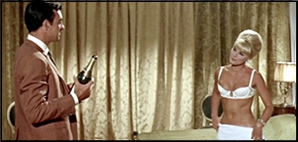
I had big hopes for this film, not least because it managed to spawn a sequel, but mainly because I had seen so much love for it on the internet.
First, the good: there’s the two glamorous female assassins, Irma and Penelope, played by Elke Sommer and Sylva Koscina. There’s an outrageously Avengers-like scene near the beginning in which they emerge from the ocean, clad in bikinis and armed with spear-guns, and kill a sunbather. There’s a cigar which fires bullets into whoever smokes it. There is the excellent Nigel Green.
Also, Leonard Rossiter (whose ability and work, of course, there isn’t a superlative strong enough to describe) dies in another Avengers-like scene in which our pair of saucy slaughterers paralyses him with a mysterious spy-fi drug and send him tumbling off the balcony of his fifteen-storey apartment building.
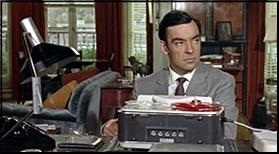
There’s also a great bit where Drummond meets his old army friend, the crime boss Boxer, who is lying low in a tropically-themed flat after faking his own death. It’s one of those instances in which the character seems to live beyond the confines of the scene he’s in.
Finally, there’s the climax, where Drummond and his nemesis creep around a life-size chess board in a duel to the death. Again, very Avengers. So, how come I don’t like the film as a whole?
Well, the plot is dull and unimaginative. It’s all about a company named Phoenecian Oil and a merger which one man on the board of directors, Henry Keller, opposes. A third party has offered to resolve the issue, via an undisclosed method, within six months and asks to receive a million pounds in return. Subsequently, Keller dies in a plane explosion, the merger can go ahead and this mysterious problem-solver demands payment. It is, of course, villain Carl Peterson and he wants to take his murderous solution to every corporation in the world.
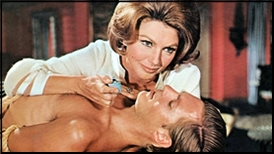
Drummond is tasked with finding out what is going on. His only lead is an inch of audio tape which Keller had recorded a message, but only half of one sentence remains. It could well reveal the answer to the mystery, if Drummond can only make sense of the jumble of words.
Unfortunately for Drummond, and indeed the viewer, his American nephew Robert has come to stay with him. Now, in order to secure distribution in the states, many British films cast an American actor in a role. This is one such example. As the ‘60s was a decade obsessed with youth, perhaps it seemed like a good idea to cast one in the film. Arguably, the result isn’t a good one, as the Robert character brings next to nothing to the film and distracts from the story it is trying to tell.
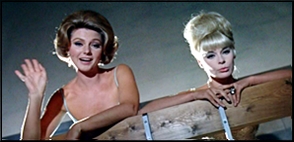
The whole movie can be divided between the first half, set in London, and the second half, which moves to Northern Italy. Here, the film seems to come to a crashing halt. Drummond meets Peterson, yes, and we get to see his castle lair, but nothing really happens. It’s this half which I have always struggled with during three previous efforts to appreciate the film.
I must reiterate, however, that the film seems popular enough with other people, and is certainly better than a couple of other Bond-pastiches of the era, such as Death Is a Woman (1966) and Hot Enough for June (1964), both of which I found to be utterly unwatchable.
Despite this, I’ll check out the sequel [Some Girls Do (1969) was the second], while I’m always in the mood to watch the older Bulldog Drummond films, and indeed the books.
Rating: **

April 30th, 2021 at 2:07 pm
And speaking of the late Richard Johnson… in November of 2005, we saw the then 78 year old Johnson as the Judge in a revival of AND THEN THERE WERE NONE in London.
April 30th, 2021 at 5:27 pm
I enjoyed this one when it first came out. But then…Elke Sommer!
April 30th, 2021 at 8:15 pm
She was quite lovely indeed. She made more than one young lad’s heart beat faster.
April 30th, 2021 at 8:17 pm
The Henry Reymond of the novelization of this movie is H(enry) R(eymond) F(itzwater) Keating. I don’t think that applies to the novelization of SOME GIRLS DO under the same byline. As might be expected with that writer its a superior novelization.
I agree this loses some momentum in the second half, but that chess game is still a classic and Nigel Green is great as Carl Peterson and Elke as Irma. James Villiers (James I of THE FIRST CHURCHILLS) replaced him in SOME GIRLS DO with Dalhia Lavi the bad girl.
Johnson also played Andrew York’s (Christopher Nicole) Jonas Wilde in DANGER ROUTE another minor Bond copy that is a favorite of Quentin Tarantino.
Leonard Rossiter who is one of Peterson’s victims here was a major star on British television with two classic series.
To some extent the Drummond books get a bad rap based on two books, THE BLACK GANG and FEMALE OF THE SPECIES. Most of the books are no more offensive than any other popular fiction from England or the US in the early Twenties and sadly only reflect popular attitudes of the largely middle class readers of the books. And it is one passage in one chapter of THE BLACK GANG that contains the offensive passage, and only the penultimate chapter of FEMALE where Drummond dons black face to penetrate Irma Petersons’s gang and rescue his wife. Beyond that McNeile’s not much worse than Dorothy Sayers or half as bad as Chesterton. Unlike Lord Peter Drummond even has Jewish friends by the thirties, albeit shop owners.
Compared to Sidney Horler and Tiger Standish, McNeile and Drummond are practically paragons. Horler was one of the worst human beings to ever put pen to paper by all accounts, racist, misogynist, sexist, and jingoist even by the standards of British popular fiction.
May 1st, 2021 at 8:35 am
This has been reviewed here before, often enough to be rated as controversial.
May 1st, 2021 at 11:07 am
Indeed. Not only is this movie a two-timer, but a three-timer.
Here’s my take:
https://mysteryfile.com/blog/?p=68687
which in turn was preceded by one submitted by one Dan Stumpf:
https://mysteryfile.com/blog/?p=13522
For some reason Elke Sommer shows up in a lot of images in all three.